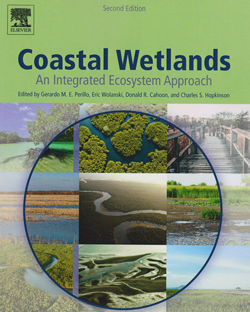
What are coastal wetlands and their features? How are they interrelated? In this extremely wide-ranging second edition of
Coastal Wetlands, 78 authors each focus on one facet of these questions as they present and synthesise our knowledge of those ecosystems situated where land meets sea. They adopt a very wide ranging definition of coastal wetlands as being (quite a mouthful, this) ‘those ecosystems along an elevation gradient ranging from the seaward limit at which benthic plants can photosynthesise (that is, the base of the photic zone) to the landward edge at which the hydraulic influence of the sea yields to the influence of groundwater and atmospheric processes’. In other words, this book covers a great variety of distinct nearshore and shoreline environments (seagrass meadows, mangrove swamps, intertidal flats, tidal salt marshes, tidal freshwater wetlands—coral reefs and rocky shores are excluded as being biologically and physically distinct). These ecosystems collectively range across all six continents.
The result is a fascinating compendium that explores not only the individual ecosystems, but also their impacts on one another, and human impacts on them. It is noted, for example, that the marsh grasses in tidal wetlands filter watershed-derived nitrogen, lessening the potential for estuarine eutrophication. Meanwhile, they act as a source of organic carbon, enhancing the productivity of coastal fisheries. It is water movement between the ecosystems that promotes the exchange of materials.
The book starts with an all too familiar refrain for ecologists: in the ten years since the publication of the first edition, coastal wetlands have undergone considerable degradation. In addition to the increasing human population densities and coastal development on their landward sides, wetlands are seaward being impacted by sea-level rise. Individual floral species are responding differently to changing climate, altering the composition of wetland ecosystems. However, coastal wetlands are of importance for human communities. A less than 6-m-high tsunami, for example, can be largely eliminated by a strip of mangroves only 10 m wide. Wider mangrove belts are advantageous. A 500-m-wide mangrove swamp could slow a large tsunami from rising in ten seconds to three minutes, allowing time to escape. Mangroves and other wetlands act as sinks for blue carbon, burying organic carbon derived from atmospheric CO
2.
I recommend this book, reasonably priced for its size, to all working on coastal wetlands, to whom it should appeal widely. It allows people working on one section of the coastal gradient to evaluate the contributions of colleagues in adjacent parts.
Reviewed by Brent Wilson
COASTAL WETLANDS: AN INTEGRATED ECOSYSTEM APPROACH, 2nd Edition, by Gerardo Perillo, Eric Wolanski, Donald R. Cahoon & Charles S Hopkinson (eds). Published by Elsevier, Amsterdam, Netherlands, 2019. 1124 p. ISBN-10: 0444638938, ISBN-13: 978-0444638939.
List price: £150.00
W: https://www.elsevier.com/books/coastal-wetlands/perillo/978-0-444-63893-9